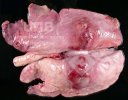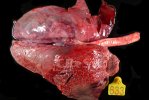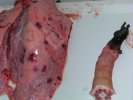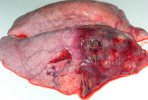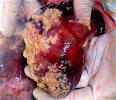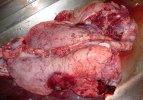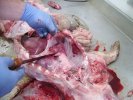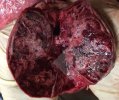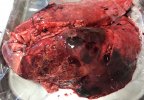App
Pleuropneumonia is a disease of bacterial origin with a high respiratory impact. The production of toxins can often cause sudden death with nasal hemorrhage.
Alternative names: Actinobacillus pleuropneumoniae, pleuropneumonia
Information
The Actinobacillus pleuropneumoniae (App) bacteria, has at least fifteen different serotypes, some of which do not produce any clinical signs, while others may cause serious disease. The serotypes vary depending on the country. Serotypes 1,2,5,9 and 11 are normally quite virulent, while serotypes 3 and 7 are quite mild. The App is transported in the tonsils and the upper respiratory tract. It is transmitted in short distances through aerosol and only survives outside the pig for a few days.
The organism may affect the pig from weaning to slaughter, but normally it affects pigs 8 to 16 weeks old. The incubation period is very short; as short as 3 hours. The toxins produced by the bacteria can cause severe pulmonary damage. Infected animals can carry the organism during several months without showing any symptom.
App is not very common in sows, unless they did not had previous contact, or unless the subclinical disease is triggered by coinfections, especially PRRS or influenza.
Symptoms
All ages
- Not very common in adult pigs and very young piglets, except when the farm did not have previous contact with App.
- Sudden death/low or high mortality – the unique symptom is a nasal bloody discharge.
- Sudden death - no symptoms, more than 1% of the deaths are in this category. Post mortem examination is necessary.
- Breathing difficulties.
- Ears turn blue.
- Severely depressed animals .
- High body temperature.
- Loss of appetite.
- Pleuritis.
- Nasal bleeding.
- Lameness.
- Pale pigs.
- Pneumonia.
- Bad general condition – deteriorated and poor looking.
Causes / Contributing Factors
- Introducing infected or carrier pigs
- Can be transmitted through fomites and visitors.
- Sudden temperature changes.
- Stress/movements.
- Nutritional changes
- Continuous flow production.
- High animal density.
- Other pulmonary diseases (PRRS, influenza).
Diagnosis
Based on the farm history, clinical signs, post mortem examination including slaughterhouse exams and culture of the organism. Pulmonary lesions are very typical. Serology may be used to identify serotypes, but its interpretation can be difficult due to cross reactivity between serotypes.
App must be differentiated from Actinobacillus suis infections, enzootic pneumonia, PRRS, influenza, and pneumonia caused by Salmonella choleraesuis.
Control/Prevention
Due to the acute course of the disease, in new outbreaks it is important to identify the clinical cases quickly and mass inject the entire group of pigs as quick disease progression can make difficult identifying affected animals. The infected pigs stop eating and/or drinking, so medicating trough feed or water is not an adequate treatment method. App is sensitive to a wide range of antibiotics.
It is important to determine the time the outbreak can take place and administer strategic medication and prevention plans.
In acute outbreaks, the population at risk should be examined three times a day in order to identify the disease as soon as possible. There are several vaccines available. These vaccines should include the specific strain of the outbreak.
Select replacement animals from herds negative to App.

